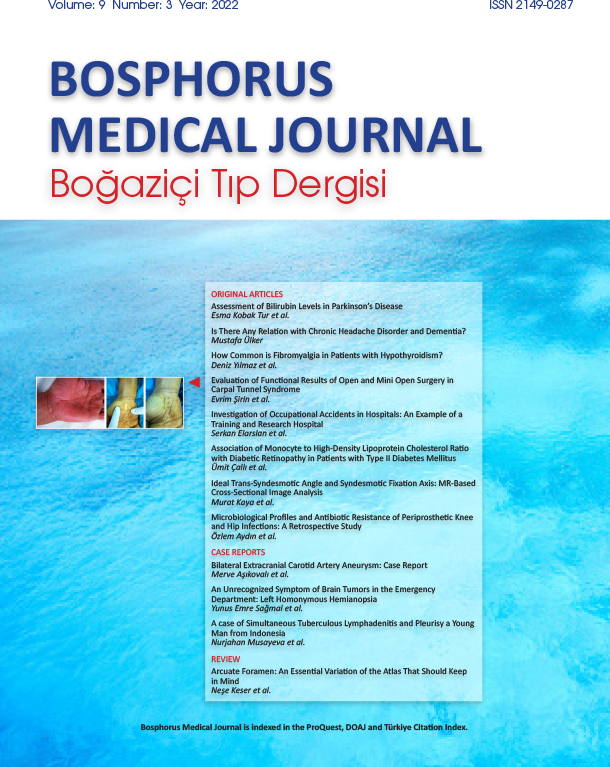Volume: 7 Issue: 2 - 2020
| ORIGINAL RESEARCH | |
| 1. | The Outcomes of Recurrent Retinal Detachment Surgery and the Effects of the First Surgeon to the Final Outcomes Hatice Nur Tarakçıoğlu, Abdullah Özkaya doi: 10.14744/bmj.2020.26928 Pages 39 - 44 INTRODUCTION: To evaluate the outcomes of vitreoretinal surgery in patients with recurrent retinal detachment (RD) and compare whether these outcomes differ regarding the surgeon who carried out the first surgery. METHODS: The medical records of the recurrent RD patients who underwent vitrectomy between January 2014 and December 2016 were reviewed for this retrospective single-surgeon study. The included patients had a postoperative follow-up period of at least 12 months. If the first surgery was carried out by the same surgeon, then the patients were included in group A, and if the patient was a referral patient and the first surgery was carried out by another surgeon, then the patient was included in group B. Primary outcome measure was the anatomical success at month 12. RESULTS: There were 12 eyes (20.7%) in group A and 46 eyes (79.3%) in group B. The anatomical success after a single secondary operation was 67.2% in the whole group. It was 75.0% and 65.2% in groups A and B, respectively (p=0.4). Final anatomical success after multiple surgeries was achieved in 46 of the 58 patients (77.6%) in the whole group. The final anatomical success was 91.7% and 73.9% in group A and B, respectively (p=0.1). DISCUSSION AND CONCLUSION: In conclusion, we detected a positive trend in anatomical outcomes after vitrectomy surgery in the subgroup recurrent RD patients that were operated by the same surgeon who carried out the first operation. |
| 2. | The Importance of Platelet Count, PDW and MPV Value in the Follow-up of Patients with Helicobacter Pylori Eradication Özgür Altun, Mustafa Özcan doi: 10.14744/bmj.2020.30602 Pages 45 - 50 INTRODUCTION: Helicobacter pylori infection is common all over the world. The present study aims to have platelet indices; to examine the role of platelet count, mean platelet volume (MPV) and platelet distribution width (PDW) as useful, inexpensive, non-invasive biomarkers for monitoring helicobacter pylori therapy. METHODS: A total of 72 patients who were determined using helicobacter pylori positivity, gastroscopic biopsy and administered eradication treatment were included in this study. Whether these patients were eradicated after treatment was evaluated by testing helicobacter pylori antigen in stool. Eradication was observed in 48 of the patients, and the demographic data and laboratory parameters of the patient group before and after treatment were compared. RESULTS: The mean age of the patients included in this study was 41.1±12.1. Of the patients, 54 were female and 18 were male. After Helicobacter pylori eradication, a decrease in platelet count and an increase in PDW were detected. The difference was statistically significant (p=0.045 and 0.015, respectively). We did not find any significant difference concerning platelet lymphocyte ratio, neutrophil-lymphocyte ratio and MPV in patients with Helicobacter pylori eradication (p>0.05). DISCUSSION AND CONCLUSION: In our study, we found a decrease in the number of peripheral platelets and an increase in PDW in patients receiving helicobacter pylori therapy and eradication. We saw that the MPV value did not change. Our findings suggest that platelet count and PDW value, which can be studied in many health institutions and are an inexpensive test, can be useful parameters that can be used to follow the Helicobacter pylori eradication treatment process. |
| 3. | The Diagnostic Value of Flexor and Extensor Forces, in Meniscus Rupture Diagnosed Cases with MRI Taşkın Ceyhan, Ibrahim Halil Ural, Şebnem Nur Atilla, Kerem Alptekin, Halim İşsever doi: 10.14744/bmj.2020.85866 Pages 51 - 57 INTRODUCTION: Changes in the knee flexor and extensor strengths have not been thoroughly evaluated. When the forces decrease, there are disruptions in the knee joint balance. Could flexor and extensor strength measurements be used as diagnostic tools for meniscal tears? METHODS: In this study, 45 patients clinically prediagnosed with a meniscal tear and confirmed with MRI were the study group. Their other knees were the control group. New 45 healthy patients were made up a negative control group. In the control and negative control groups, MRI was not taken. The maximal strengths of all knees in Study and Control Group and a series of the negative control Group were measured using Nonius EnRaf R, kg unit and air pressure isokinetic exercise device. Other pathologies in the knees, the onset of pain, duration, age, and left and right differences were not evaluated. Statistical ROC analysis was carried out. RESULTS: There was a 17% of flexion and 30% of extension reduction in the knee with ruptured meniscus compared with intact knees. Both values were statistically significant (p<0.05). The mean knee flexor/extensor strength ratio in ruptured meniscus, patients was 0.687, while it was higher than 0.81 in other intact knees. As a result, the extension 32 units in 35 out of 45 patients, flexion 20 units in 36 out of 45 patients were affected, respectively, 35 out of 45 healthy knees were affected in other knees. DISCUSSION AND CONCLUSION: Change in muscle strengths can be used to confirm with a prediagnosed meniscus tear in knees. Measurements of many knee forces with other pathologies can be definitive and widespread in the diagnosis.. |
| 4. | The Effects of Low Molecular Weight Heparin on Microalbuminuria in Patients with Type II Diabetes Mellitus Meltem Sertbaş, Mutlu Niyaz, Güven Çetin, Nalan Okuroğlu, Yaşar Sertbaş doi: 10.14744/bmj.2020.02419 Pages 58 - 62 INTRODUCTION: Diabetic nephropathy is one of the major complications of diabetes, with a frequency of 20-40% and high mortality. Different treatment modalities are required for the progression and prevention of nephropathy apart from the conventional treatment approaches. The present study aims to investigate the effects of low molecular weight heparin, Nadroparin on microalbuminuria. METHODS: Forty-four Type II diabetic patients between the ages of 30-70 who were followed up from the internal medicine outpatient clinic and service were included in this study. Nadroparin, an LMWH for one month, was administered subcutaneously at a dose of 3075 IU to randomly selected 22 patients. The other 22 patients were followed up without any treatment as a control group. RESULTS: There was a significant decrease in urea (43.2±18.3 and 34.9±7.9) and creatinine (1.13±0.32 and 0.9±0.3) values between basal and after 1-month treatment of Nadroparin (p<0.05). Meanwhile, there was not any significant difference between the basal values and values after in the control group (p>0.05). There was a slight increase in creatinine clearance values after one month of treatment, which was not statistically significant (p>0.05). Although a 15% decrease in patients was achieved after treatment with Nadroparin, the change in microalbuminuria (137.6±99.3 and 116.4±114.1) was not significant. DISCUSSION AND CONCLUSION: As a result, in our study, although it was not statistically significant, there were a decrease of microalbuminuria levels after the application of Nadroparin with LMWH, and our findings suggest that it should be considered in patients with microalbuminuria, even if it is not a part of standard treatment. |
| CASE REPORT | |
| 5. | An Unusual Case of Piriformis Syndrome: Peroneal Neuropathy Gamze Gül Güleç, Ilknur Aktaş, Feyza Ünlü Özkan, Dilşat Bayrak doi: 10.14744/bmj.2020.29290 Pages 63 - 66 Piriformis syndrome (PS) is a syndrome consisting of symptoms that occur due to compression of the sciatic nerve at the level of the piriformis muscle (PM). The most commonly reported complaints (cardinal features) are radiation to the ipsilateral tight, buttock pain, and reproduction of pain on prolonged sitting. In this study, we report a 64 years old female case presented with peroneal neuropathy symptoms without gluteal pain and sciatica and treated using ultrasound-guided PM injection successfully. |
| 6. | An ALS Case Presented with Man in the Barrel Syndrome Hatice Ferhan Kömürcü, Ömer Anlar doi: 10.14744/bmj.2020.57431 Pages 67 - 69 Man in the barrel syndrome (MBS) can be the clinical presentation in many diseases. The variants of amyotrophic lateral sclerosis (ALS) may be presented with MBS clinical picture. Determining the etiological cause by making a differential diagnosis is essential for the treatment and prognosis of the disease. Here, a case presented with the MBS clinical picture and diagnosed as ALS is reported. |
| REVIEW | |
| 7. | Bone Pathology in Multiple Myeloma: Diagnosis and Treatment Erhan Okay, Korhan Özkan doi: 10.14744/bmj.2020.65365 Pages 70 - 74 Multiple myeloma is the most common primary bone disease. Incidence has been reported as 3/100.000 in the United States. This neoplasia is characterized by osteolytic bone destruction and monoclonal proliferation of plasma cells. Multiple myeloma is the most common haematologic malignancy after Non-Hodgkin lymphoma and the most common primary bone malignancy in elderly population. Orthopaedic complaints include pain, pathologic fracture, osteoporosis, hypercalcemia and spinal cord compression. Chemotherapy constitutes the main treatment. Surgical intervention should be as minimal as possible and chemotherapy should be started as soon as possible. The risk of infection should also be considered. This review aimed to synthesize the diagnosis and treatment of bone involvement in myeloma disease. |




















